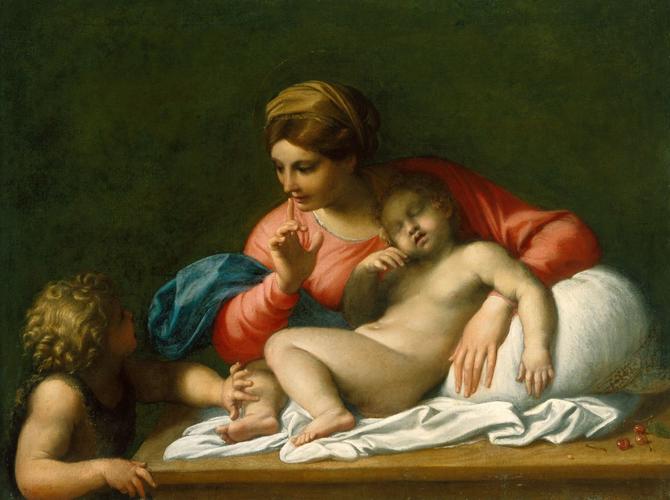The Madonna and Sleeping Child with the Infant St John the Baptist ('Il Silenzio') c.1599-1600
Oil on canvas | 51.2 x 68.4 cm (support, canvas/panel/stretcher external) | RCIN 404762
-
In this small devotional painting, the Virgin raises her finger to her lips to warn John the Baptist not to wake the sleeping Christ. Christ's future sacrifice is alluded to by the resemblance of the table to an altar or tomb and the shroud-like cloth on which he sleeps. The cherries, of which one has already been eaten, symbolise heaven.
This small devotional painting dates from the time when Annibale Carracci was completing his greatest work, the Palazzo Farnese ceiling in Rome, which merged Roman classicism with the study of natural forms. The idea of Christ asleep prefiguring his death is found in Raphael's composition, the Madonna of the Diadem (Louvre), which explores the theme of the Madonna of the veil, in which the lifting of the veil is a symbol of revelation, alluding to the cloth covering the chalice at Mass and the sheet that covered the dead Christ. Christ's future sacrifice is alluded to by the resemblance of the table to an altar or tomb and the shroud-like cloth on which he sleeps. The cherries, of which one has already been eaten, symbolise heaven as 'fruits of paradise'. The Virgin may be read as cautioning John not to awaken Christ to his Passion before his time. There is a black chalk and pen and ink preparatory drawing for the whole composition (previously in the Duke of Sutherland's collection), including the figure of John reaching out to touch Christ. This gesture is similar to that of the putto touching a spine of the crown of thorns in Annibale's Pietà (Capodimonte, Naples), which dates from the same period. The sharing of the motif suggests that Annibale was working out ideas for both paintings at the same time. In both Il Silenzio and the Pietà there is a carefully balanced pyramid composition, with the crucial gesture of the Virgin holding the centre.
Annibale may have seen Sebastiano del Piombo's very Michelangelesque version of the subject (Capodimonte, Naples) of the 1530s, as it was in the Farnese collection at this time. Annibale's painting was also in the Farnese collection, recorded by Malvasia in the Palazzo del Giardino in Parma in 1678. Annibale probably derived the gesture of enjoining silence from Michelangelo: in a red chalk presentation drawing by him (private collection), usually dated to the 1540s, the Holy Family is shown with an older John the Baptist and it is he rather than Mary who puts his finger to his lips. Such a considered use of Renaissance sources gives Il Silenzio grandeur despite its modest size. Each form is clearly delineated with the classical restraint typical of Carracci's style at this time. In the subdued atmosphere the figures emerge from deep shadows. Annibale also pays close attention to details, such as the children's delicate curls, the fringe of the Virgin's turban, the cherries and the finely painted fingers. The Christ Child has the weight of natural sleep, his stomach relaxed, his mouth slightly open, but his hand is paler than his mother's on which he rests, alluding to his future death. Annibale made small but important changes, some clearly visible, others only in infra-red reflectography and x-radiography, as he devised this strong and deceptively simple composition.
The painting was much copied, reinterpreted and quoted, especially after it was acquired by George III in 1766. A squared-up composition by Sassoferrato is perhaps related to the most notable copy of the painting attributed to Domenichino (Louvre) which was probably painted c.1605, and therefore very shortly after the original. The painting was engraved by Bartolozzi while it was at Buckingham House in 1768; Dalton, who bought the painting for George III, owned the preparatory drawing. Francis Cotes's Queen Charlotte with the Princess Royal of 1767 (Royal Collection) depicts the Queen silencing the viewer with her raised figure, so as not to wake the sleeping princess, as a homage to the recent acquisition.
The painting appears in Pyne's illustrated Royal Residences of 1819, hanging in the King's Dressing Room at Windsor Castle (RCIN 922105).
Catalogue entry adapted from The Art of Italy in the Royal Collection: Renaissance and Baroque, London, 2007Provenance
Recorded in the Farnese collection in the Palazzo de Giardino, Parma, 1678 and c.1680; purchased for George III by Richard Dalton, 27 May 1766 for £262; recorded in the King's Closet at Buckingham Palace in 1774 (see RCIN 926315) and 1790
-
Creator(s)
Acquirer(s)
-
Medium and techniques
Oil on canvas
Measurements
51.2 x 68.4 cm (support, canvas/panel/stretcher external)
74.2 x 91.1 x 7.4 cm (frame, external)
Category
Object type(s)
Other number(s)
Alternative title(s)
'Il Silenzio'









